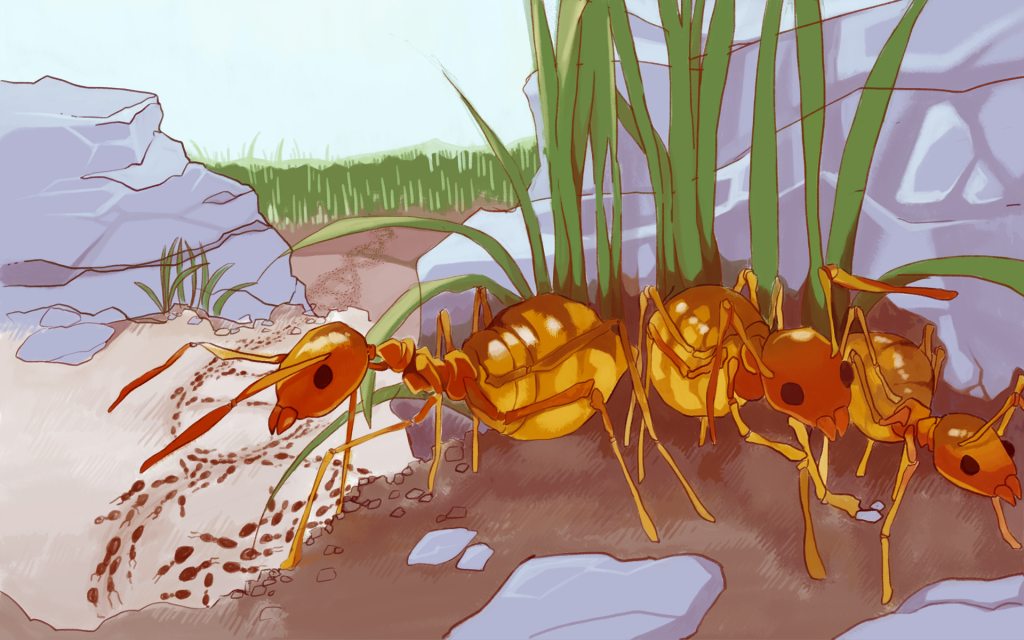Survival strategy: How crazy ants overcome ‘invasion paradox’

Tawny crazy ants’ pattern of genetic inheritance may have helped the South American species spread in the United States, Texas A&M AgriLife researchers have discovered. The results could lead to a new way to control this invasive species.
“We might be able to use the mechanism to drive a lethal gene into the population,” said Ed Vargo, senior investigator of the study and professor of urban and structural entomology in the College of Agriculture and Life Sciences at Texas A&M University.
Also known as Rasberry crazy ants, the species has been spreading in Texas since at least 2002. Crazy ants can kill grass, displace other insects and destroy electrical equipment, causing a lot of damage in urban and rural areas. What’s more, their colonies can evade typical pest control tactics. They can thrive both indoors and outdoors. They ignore baits and create numerous escape routes from their supersized colonies.
Tawny crazy ants were named for their random-looking walk, but the way they pass down genes to the next generation may also be described as crazy.
The team investigated crazy ant colonies in Texas and Florida cities.
Vargo and lab members Pierre-André Eyer and Alexander Blumenfeld found that in this species, the females were much more genetically diverse than one would expect from pure chance. Females tend to inherit their mother’s genes, and males tend to inherit their grandfather’s. And, males and females are quite different genetically. The pattern of inheritance seems to be unique among 15,000 ant species.
The study was published in Proceedings of the National Academy of Sciences in November.
Tawny crazy ants’ success as an invasive species represents one solution to the so-called invasion paradox: How can a small number of animals move to a new area and reproduce without suffering from genetic disorders due to inbreeding?
One way that species can fight inbreeding, scientists have hypothesized, is by making use of the differences between males and females.
Scientists have known for a long time that males and females can develop dissimilar genetic traits. Some of these traits cause problems for one sex and help the other. Such traits are normally found in sex chromosomes, such as X and Y in mammals. But ants, and their relatives, bees and wasps, have no sex chromosomes. Instead, a female has two copies of the genome while a male has one.
Scientists have hypothesized that in species where females have two copies of the genome and males have only one, the whole genome can act like a sex chromosome. A gene’s effect might be canceled or masked by another version of the same gene. In this way, a gene can be harmful and recessive in females but favorable and dominant in males, where it can’t be masked by a second copy.
The researchers analyzed several spots in crazy ants’ genome and discovered that ant colonies have three distinct versions of a certain genetic region. The team called the three versions A, B and C. If ants inherited the genes at random, a male ant could carry version A, B or C. A female could carry any combination of two versions. Instead, the team found something completely different. The vast majority of adult crazy ant females carried A/B or A/C. Adult males possessed only A.
This strategy ensures that each generation is genetically diverse. But it comes at a cost, said Vargo and Eyer. The team found that many female eggs have genetics that don’t fit the A/B or A/C pattern. These eggs seem to disappear from the nest before they can develop. The team hypothesizes that these eggs — almost 40 percent — either die or are destroyed by ants in the nest.
“There’s something about the genes and their expression that’s harmful to females,” said Vargo.
The study “fills a gap in our understanding of the inheritance of traits by males and females and shows how conflicts between the sexes can occur at the genomic level,” Vargo said. “This is a very positive finding.”
Next, the team plans to study whether the same crazy pattern of inheritance appears in the ants’ native Brazil or is just a consequence of being in a new place. Either way, the results would shed light on the weird and powerful adaptability of the tawny crazy ant.

